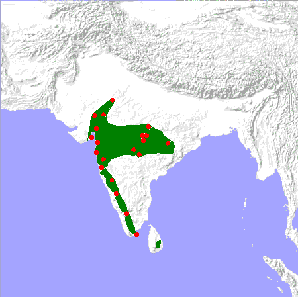चित्ता तीतर
साँचा:taxobox/speciesसाँचा:taxonomyसाँचा:taxonomyसाँचा:taxonomyसाँचा:taxonomyसाँचा:taxonomyसाँचा:taxonomyसाँचा:taxonomy
| चित्ता तीतर Painted francolin | |
|---|---|

| |
| चित्ता तीतर | |
| Scientific classification | |
| Binomial name | |
| Francolinus pictus (जार्डीन व सेल्बी, 1828)
| |

| |
| भौगोलिक विस्तार | |
| Synonyms | |
|
पर्डिक्स पिक्टा |
चित्ता तीतर (Painted francolin), जिसका वैज्ञानिक नाम फ्रैंकोलिनस पिक्टस (Francolinus pictus) है, भारत व श्रीलंका में मिलने वाली तीतर की एक जीववैज्ञानिक जाति है।[१][२][३][४]
विवरण
चित्ता तीतर मध्य व प्रायद्वीपीय भारत के घास के इलाकों में और दक्षिण-पूर्व श्रीलंका के निचले इलाकों में पाया जाता है।[५] क्योंकि यह पक्षी हिन्दी भाषी प्रदेशों में नहीं पाया जाता है इसलिए इसका हिन्दी नाम भी नहीं है। लेकिन पश्चिमी तथा दक्षिणी भारतीय भाषाओं और सिंहला भाषा में इस पक्षी का नाम है। प्रजनन काल में यह पक्षी अपनी तेज़ आवाज़ के कारण आसानी से पहचाना जा सकता है। यह काले तीतर की मादा से थोड़ा भिन्न दिखता है क्योंकि इसके गर्दन के किनारों में लाल रंग नहीं होता है। यह एक मध्यम आकार का पक्षी है जिसकी लंबाई तक़रीबन ३० से.मी. होती है और वज़न लगभग ३१० से ३७० ग्राम होता है।[५] कई क्षेत्रों में यह अपना इलाका काले तीतर के साथ सांझा करता है और ऐसा मानना है कि कहीं-कहीं यह आपस में प्रजनन भी करते हैं।[६]
इन्हें भी देखें
सन्दर्भ
- ↑ स्क्रिप्ट त्रुटि: "citation/CS1" ऐसा कोई मॉड्यूल नहीं है।
- ↑ Crowe, Timothy M.; Bloomer, Paulette; Randi, Ettore; Lucchini, Vittorio; Kimball, Rebecca T.; Braun, Edward L. & Groth, Jeffrey G. (2006a): Supra-generic cladistics of landfowl (Order Galliformes). Acta Zoologica Sinica 52(Supplement): 358–361.
- ↑ Madge, Steve; McGowan, J. K.; Kirwan, Guy M. (2002). Pheasants, Partridges and Grouse: A Guide to the Pheasants, Partridges, Quails, Grouse, Guineafowl, Buttonquails and Sandgrouse of the World. A. C. Black. ISBN 9780713639667.
- ↑ Bent, Arthur C. 1963. Life Histories of North American Gallinaceous Birds, New York: Dover Publications, Inc.
- ↑ अ आ साँचा:cite bookThe Painted Partridge may be said to take the place of the Black in Central and part of Southern India. It is found throughout Bundelkund and the Saugor and Nerbudda territories, and thence south through Nagpore and the Deccan, to about N. L. 15°, gradually becoming more scarce southwards. I have heard of its occasional occurrence near Bangalore still further south, but where the land is higher and the climate cooler. West, it extends into Candeish, and perhaps Guzerat, but is not known on the Malabar Coast; and eastwards, it is found throughout Chota Nagpore and adjacent lands to the more open parts of the Northern Circars, as far as Cuttack, but far more rare there than in the west of the Peninsula. I have found it most abundant in the Deccan near Jalna, and at Mhow ; less so in Saugor, Nagpore and Hyderabad.
- ↑ साँचा:cite book